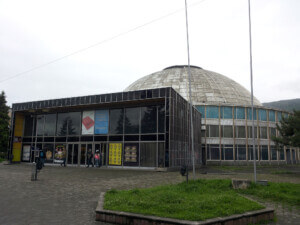While the opening night of Philharmonic Hall at Lincoln Center on September 23, 1962, was hailed as a watershed for the arts within New York City, it might have gone unnoticed by those living elsewhere. That is, were it not for an eponymous CBS News TV special, in which Aline Saarinen introduced the glamorous new hall to millions of Americans. At least for one night, architecture was at the center of the country’s most prominent stage.
Television was by no means the only mass medium in which the public or professionals could find information about architectural design, although it arguably provided the widest exposure on such topics. By the time Saarinen was telling viewers about the new concert hall in New York, around 90 percent of American homes contained a TV set. The new medium played a key role in raising the profile of architecture in the United States and, in particular, helped establish the idea in the minds of the American public that architecture was art, but also a commodity to be consumed.
Programming about architecture and design, as well as the arts more generally, filled the television broadcasting day virtually from the moment there was a broadcasting day to fill. These shows had the sheen of high culture but also leveraged the full potential of a highly visual medium, making them attractive to network executives as a way of elevating TV’s cultural cachet while also selling TV sets. At the same time, television was useful to arts organizations as well as architects, designers, and museum curators, in their efforts to reach new audiences and patrons. In the 1950s, the Museum of Modern Art in New York embarked on a “Television Project” that resulted in, among other things, a series of TV appearances by Edgar Kaufmann Jr. on Margaret Arlen’s CBS morning show, in which he presented objects from his “Good Design” program. The American Institute of Architects, having only recently embraced public relations, extolled “The Great New Medium, Television” in its monthly PR newsletter in 1953. AIA chapters across the U.S., in Spokane, Washinton; central Florida; Dallas; central New York state; and elsewhere soon took up the call to promote their profession, producing programs with titles like “So You Want to Build” (1953) and “Design for Your Living” (1954). Many individual designers and architects also got in on the act. Charles and Ray Eames debuted their chaise lounge on NBC’s Home show in 1956, while Philip Johnson appeared with Louis Kahn on an episode of the CBS show Accent titled “The Architect.” Frank Lloyd Wright was a veritable fixture on television during these years, appearing on game shows and specials, as well as in interviews that networks continued to rebroadcast in the years after his death in 1959. (Wright was eulogized in the AIA Journal by TV host Alistair Cooke.)
Some programs did present critical appraisals of architecture projects, as in the case of a 1963 episode of David Brinkley’s Journal, which argued that the modernist planned city of Brasília was an almost deserted place that few Brazilians wanted to visit or live in. But on the whole, the image of architecture presented in such programming was positive and upbeat, informed by producers’ marketing and promotional goals. Programs emphasized architecture’s prestige quality. Hugh Downs, host of an episode of the NBC News program World Wide ’60 dedicated to architecture, perhaps summed the mood up best, describing the spatial art as an expression of humankind’s “search for beauty and elegance…a good deal more than a few lines on a blueprint.” Other shows highlighted architecture’s potential to make viewers’ lives more comfortable and efficient. A sequence tracing Skidmore, Owings & Merrill’s efforts to redesign a bus terminal in Chicago, featured on the arts program Omnibus in 1953, highlighted the architects’ role in making “an efficient terminal, comfortable and pleasant, with every passenger freed of all the nuisance and trouble” that characterized the old, out-of-date structure it was set to replace.
These two seemingly contradictory ideas about good architecture—that it was an art form and that it made everyday life more comfortable—frequently merged in a discourse that emphasized the pleasurable physical and intellectual experiences well-designed spaces could engender. Good architecture should “elate the onlooker,” argued Walter Gropius in a 1958 interview for the NBC program Wisdom, and provide physical as well as “inner comfort.” Eero Saarinen’s architecture, according to Aline Saarinen, speaking on a 1967 episode of Creative Person, had a way “of making you feel as if you wanted to take a deep breath, of standing taller, of being a human being.” “You enter a well-designed building,” claimed Philip Johnson on World Wide ’60, “and you feel better and you put on a necktie because it seems a more formal and glorious place to be.” In a televisual tour of the 1957 Buildings for Business and Government exhibition at MoMA presented on Omnibus, critic Brendan Gill praises the terminal at Lambert Airport in St. Louis (Minoru Yamasaki, 1953–56), saying: “Comfort is here, and convenience. Hardly less important is the sense of pleasurable anticipation that this brilliant cage provides. For this is a happy marriage between inside and outside, between the world of flight and the irritating world of only waiting to fly. Though on the ground, you have the sense of already being contentedly airborne.”
As the “you” address adopted in many of these programs (“you feel better,” “you have the sense”) makes clear, these programs were invitations to the TV audience to take part in the experience of these spaces, often through consumption. Any viewer, such programs implied, could delight in the comfort of an Eames chaise lounge by purchasing one, or in the beauty and efficiency of Lambert Airport Terminal by buying a plane ticket. The image of architecture TV conveyed was one in which buildings were regarded simultaneously as works of art and as consumer goods, capable of satisfying viewers’ practical needs as well as elevating them intellectually and spiritually.
Of course, purchasing a television was the other way in which viewers could partake in the experience of architecture. Many early TV producers, including the influential NBC News president Reuven Frank, sought explicitly to use TV to re-create for viewers the experience of a particular site or event. Referencing an Emmy Award-winning NBC documentary about an escape from East Berlin, Frank told The New York Times in 1965, “You can get all the facts in a newspaper. Television can show you what it’s like to be digging an escape tunnel.” The approach Frank endorsed was evident across TV programming in these decades. Gill’s description of Lambert Airport Terminal on Omnibus, for example, unfolded against tight close-ups of its architectural model, which featured tiny passengers scattered through the terminal. Background sounds of jet engines and muffled PA announcements completed the effect of verisimilitude. World Wide ’60 was premised specifically on live transmissions beamed to viewers’ homes from all over the world, a feat made possible by the new technology of the telecommunications satellite. Taking full advantage of such advances, the series’ episode “The Shape of Things—Architecture” began by transporting viewers to architectural sites throughout the world, including the Great Pyramid in Giza, the Via Veneto in Rome, the Ritz Hotel at the Place Vendôme in Paris, and a public housing estate in London.
The presentation of architecture on TV is noteworthy for its use of visual spectacle to virtualize viewers’ experience of it, but also for the way in which the messages presented in one program could be reinforced by those that aired before or after it, or in the advertising of its sponsors. Images of modernist structures like Lever House (1950–52) or the Seagram Building (1954–58) were visible not only on Omnibus, Accent, and World Wide ’60 but also in the news coverage of divided Berlin that proliferated leading up to and following the 1961 erection of the Berlin Wall. Programs like the U.S. Army documentary series The Big Picture, the newsmagazines CBS Reports and Close Up!, and network news specials like “The President at the Wall” (1963) all incorporated liberal footage of modernist architecture in West Berlin, such as a housing complex designed by Walter Gropius and The Architects Collaborative (1957). The 1962 broadcast from opening night at Lincoln Center’s Philharmonic Hall, designed by Harrison & Abramovitz, included a commercial for the program’s sponsor Corning Glass that consisted of a tour of its new Glass Center, also designed by Harrison & Abramovitz.
While their precise influence is difficult to gauge, in the visual and narrative discourses about architecture on American TV in the 1950s and 1960s, one can easily detect the seeds of what would blossom in the 1970s and ’80s into a culture of global architectural spectacle, associated with works like Renzo Piano and Richard Rogers’s Centre Pompidou in Paris (1971–77) and Frank Gehry’s Guggenheim Bilbao (1993–97). The very idea that a building could and indeed should have a significant impact beyond its immediate milieu, its image carried via mass media to audiences (and potential visitors) around the world, is one that television clearly played a role in shaping and promoting.
Emily Pugh is an architectural historian based at the Getty Research Institute in Los Angeles. Her work focuses on postwar architecture in the U.S. and Germany, as well as technologies of architectural representation. Her first book, Architecture, Politics, and Identity in Divided Berlin (2014), is available from the University of Pittsburgh Press. She is at work on a second book, focused on architectural criticism on U.S. television in the 1950s and 1960s.











